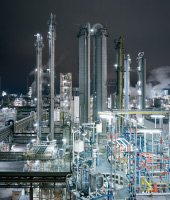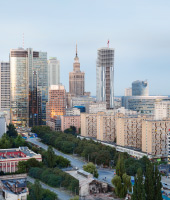The WACKER Group’s Prospects
Our expectations are based on the assumption that the global economy will grow in 2015. The largest growth impetus will come from Asia and the USA, with subdued growth in Europe.
Our capital expenditures in 2015 will prioritize the completion of our polysilicon production site in Tennessee (USA), which we aim to start up in the second half of 2015. In general, we are shifting our investment focus toward plants for manufacturing downstream products. WACKER’s priority is to grow its business organically. In our opinion, the applications and markets that we are addressing will continue to offer good growth potential. Investments will exceed depreciation in 2015 due to the completion of our polysilicon production site in Tennessee (USA). Our 2016 capital expenditures will fall below the level of depreciation.
WACKER POLYMERS is expanding its production facilities for dispersible polymer powders in Burghausen (Germany) and for dispersions in Calvert City (USA). In Burghausen, a new 50,000 metric-ton reactor is being built for dispersible polymer powders and, in Calvert City, we are expanding our existing dispersions plant by 85,000 metric tons. At WACKER SILICONES, investments will flow into the completion of a plant for modified silicones in Burghausen. At Siltronic, capital expenditures are focused on meeting the latest design-rule specifications for 300 mm technology.
Future Products and Services
WACKER POLYMERS is intensifying its activities in polymeric binders for modifying dry-mix mortars. Demand for high-quality construction materials is growing in Asia, South America and Eastern Europe. We have developed special dispersible polymer powders for sophisticated tile adhesives that securely bond heavy, large-format porcelain and natural-stone tiles. Transparency Market Research projects that tile-market growth will average 9 percent annually until 2018.
Worldwide demand for paints and coatings is growing, especially for environmentally friendly water-based products. Researchers at Orr & Boss estimate that the global coatings industry will be worth around US$ 140 billion by 2017, with Asia accounting for about 50 percent of this amount. The market researchers also expect sales growth in South America, Africa and the Middle East. We aim to expand our market position in these regions with specialty VINNAPAS® VAE dispersions that are adapted to local requirements for use in environmentally compatible interior paints.
In the electronics sector, WACKER SILICONES is developing silicone gels for low-reflection displays, and heat-dissipating adhesives and sealants for automotive and power electronics. In lighting technology, we will see the increasing use of highly transparent liquid silicones for flexible optical lenses. These lenses improve light control in LED lamps. As a result, high-performance silicones play a key role in the development of new, adaptive headlamp systems for cars. According to a McKinsey study, the lighting market will grow to € 100 billion by 2020, with annual growth rates of between 3 and 5 percent.
In cosmetics and personal care, we are developing new silicone additives. The emphasis in Asia is on silicone elastomer gels for formulating skin creams and make-up. In China and India, we are expanding our portfolio of silicone emulsions for shampoos and conditioners. The global market for cosmetics and personal-care products is growing by 3 percent, according to Euromonitor. Impetus for growth is coming primarily from South America (5 percent), Asia (4 percent) and the Middle East (4 percent). Asia has already become the world’s largest market, with the value of goods sold exceeding € 83 billion.
In construction, WACKER SILICONES is focusing on silane-modified hybrid polymers, used in formulating highly durable industrial adhesives, coatings and sealing membranes. We also expect growth momentum from our silicone additives for polymer modification, as they will increasingly replace organic additives. The global market for these additives will grow by around 5 percent annually until 2020, according to BCC Research. In addition, we are introducing new defoaming agents for the paper and pulp industry.
The global volume of nutritional supplements and food products offering additional benefits is rising. Using our cyclodextrin technology platform, WACKER BIOSOLUTIONS aims to profit from further growth in these markets, for example with a highly bioavailable curcumin complex. Transparency Market Research expects the global market for food supplements to grow by an average of 6 percent annually. We have fundamentally refined our patented secretion technology, ESETEC®. In cooperation with MedImmune (Astra Zeneca’s R&D division for biologics), WACKER has completed a successful market feasibility study for manufacturing a special active ingredient using the improved ESETEC® 2.0 system. MedImmune commissioned WACKER to find a cost-effective methodology for antibody-fragment production for future therapies. Studies conducted by Research and Markets indicate that the biologics market will be worth about US$ 500 billion by 2020, with annual growth rates of around 13 percent.
Research and Development
The Group’s research and development work will remain focused on key strategic projects. WACKER intends to spend 20 percent (2014: 20 percent) of its R&D budget on these projects in 2015. One major aspect of R&D work in 2015 will be to bring to market the initial results of our New Solutions project – an initiative for developing technically and commercially superior solutions for new applications. The R&D budget planned for 2015 amounts to about € 185 million. Our R&D priorities remain the highly promising fields of energy, consumer care, biotechnology, construction applications and semiconductors. We are devoting particular attention to energy storage and renewable energy generation.
Production
WACKER will bring additional production capacity on stream over the next two years. WACKER POLYSILICON plans to start up polysilicon production at the new site in Tennessee (USA) in the second half of 2015. WACKER POLYMERS is expanding its annual capacity in Burghausen for dispersible polymer powders by 50,000 metric tons, and for specialty monomers by 3,800 metric tons. At the Calvert City (USA) site, a facility is being built to manufacture 85,000 metric tons of dispersions annually. At WACKER SILICONES, we are expanding a plant for modified siloxanes, scheduled to start up in 2015. The Group’s “Wacker Operating System” (WOS) program is focused on further improving the productivity of production facilities and all production-related service departments. This involves scrutinizing all the main productivity levers (raw-material and energy efficiency, maintenance, capacities, and labor productivity). The emphasis is on key projects that have a high economic impact on both costs and benefits.
Facility Start-Ups in 2015
|
|
||||
|
Location |
Projects |
Start-Up |
||
|
|
|
|
||
|
Charleston |
Polysilicon production plant |
2015 |
||
|
Calvert City |
Dispersions reactor |
2015 |
||
|
Burghausen |
Polymer powder dryer |
2015 |
||
|
Burghausen |
Specialty monomers |
2015 |
||
|
Burghausen |
Expansion of MSA plant (modified siloxanes) |
2015 |
||
Maintenance costs will rise in 2015 to around € 410 million, due to the start-up of the new production site in Tennessee (USA) and to 300 mm wafer production at Siltronic Silicon Wafer Pte. Ltd. in Singapore.
Procurement and Logistics
Energy and raw-material procurement continues to have a significant influence on WACKER’s profitability. Our energy and raw-material costs account for over one-third of the cost of goods sold. WACKER anticipates diverging trends for raw-material prices. In our opinion, prices for silicon metal will climb in 2015 due to production outages in Brazil, the world’s second-largest silicon producer. For vinyl acetate monomer (VAM), we expect a substantial drop after the very high prices of 2014. The price for ethylene, coupled to the price of oil, will also decline in 2015. We anticipate that the 2015 trend for methanol prices will be flat.
We assume that electricity prices will remain flat in 2015, whereas gas prices will go up slightly year on year. Energy costs for 2015 will remain at about the same level as last year.
Supplies of raw materials and energy in 2015 are essentially secured. The markets where we source our raw materials are sufficiently liquid for bottlenecks to be unlikely. In the coming two years, we will continue to broaden the international base of WACKER’s WACKER’s portfolio of raw-material suppliers. At the same time, we will keep an even sharper eye on the raw-material purchasing sources that are relevant to us, so that we can access new suppliers.
We have adopted the same approach with technical procurement, where we continue to systematically optimize our supplier portfolio in order to measurably increase the business value contribution to the company’s success in the coming years. Our emphasis here is on systematically expanding our global procurement network, with two main areas of focus. In line with our policy “from the region and for the region,” we will specifically scout out suitable local suppliers as WACKER partners for new projects in Asia, primarily China and South Korea. At the same time, we will expand procurement from China, India and South Korea for our sites in the Americas and Europe. These efforts also involve enhancing the IT and communication networks of our international procurement organization. Key areas are the gradual internationalization of work on goods categories and regular information-sharing by the regional purchasing organizations.
WACKER wants to intensify its commitment to sustainable management in the supply chain. For this reason, our company joined the chemical industry’s “Together for Sustainability” initiative (TfS) in January 2015. Founded in 2011, this organization aims to develop a global program for responsible procurement of goods and services and to improve the ecological and social standards of suppliers.
In logistics, we intend to shift more freight from road to rail, thanks to the new public freight terminal (combined road/rail terminal) in Burghausen.
Sales and Marketing
For its silicone customers, WACKER will augment its technical centers in both Moscow and Dubai to develop new applications on-site for silicone rubber and for silicone elastomers. Following the 2014 opening of a new sales office in the Philippines, we will expand our sales team there. In Brazil, we plan to broaden marketing efforts in the areas of foodstuffs, agriculture and textiles with the help of distribution partners. The key tradeshows for us in 2015 include the European Coatings Show (ECS) in Nuremberg, in-cosmetics in Barcelona, Fakuma in Friedrichshafen and Compamed in Düsseldorf. At ECS, WACKER will present new binders for high-strength industrial adhesives and a silicone resin for formulating wood coatings.
Employees
We expect employee numbers to increase in 2015. This is due primarily to the start-up of polysilicon production in Tennessee (USA) and an anticipated increase in production at WACKER POLYMERS and WACKER SILICONES. WACKER, however, will continue its conservative approach toward hiring new employees.
Sustainability
WACKER will keep its focus on improving its energy efficiency. The planned start-up of polysilicon production in Tennessee will increase our electricity needs. We aim to reduce our weighted specific energy consumption (amount of energy per unit of net production output) in Germany by one-third by 2022, with 2007 as the base year.
The main sources of our greenhouse gas emissions are energy generation and consumption. For this reason, WACKER’s target at its German sites is to achieve a 15-percent drop in specific CO2 emissions per metric ton of net production between 2014 and 2022 – based on the year 2012 and maintaining a similar product portfolio. We want to lower dust emissions by 25 percent by 2022 – while maintaining a similar product portfolio. We also pursue the goal of reducing emissions from non-methane volatile organic compounds (NMVOCs). Using the adjusted methods for assessing NMVOC emissions we will determine new potential for reducing this substance. With these quantifiable environmental goals, we intend to decrease the impact of our production activities on the environment.
Our 2015 goal for occupational safety is to reduce our groupwide accident rate (the number of workplace accidents per million hours worked) to below 2.0.
We are preparing another 145 substance dossiers for the third stage of REACH, which runs until mid-2018. We will publish further descriptions of the safe, environmentally compliant use of chemicals (GPS safety summaries) for the substances we have registered with the European Chemicals Agency (ECHA).
WACKER will publish its 2013/2014 Sustainability Report in 2015.



